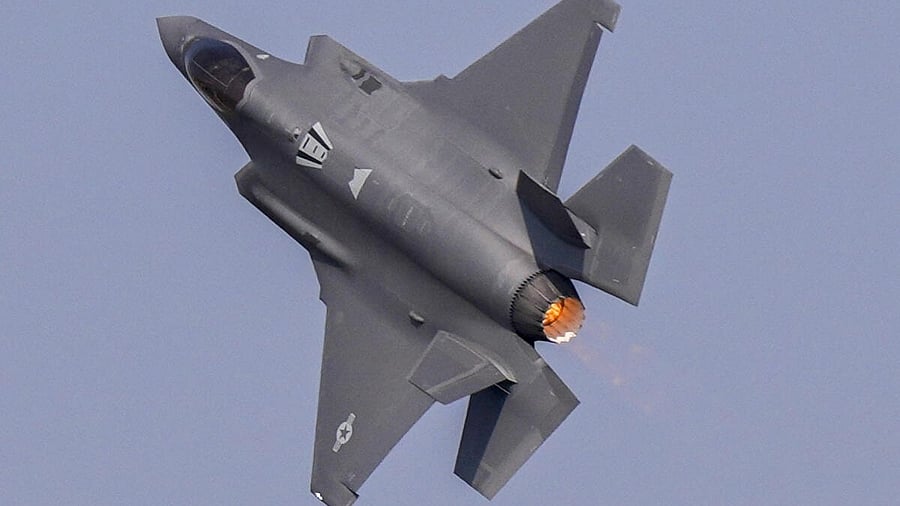
Fighter aircraft F-35
Credit: PTI Photo
The show is over. It's time to go beyond the pomp. The USA’s F-35 and Russia’s Su-57 fifth-generation combat jets thrilled the audience at Yelahanka during Aero India 2025. But does it make sense for New Delhi to buy these super-expensive aircraft to arm the Indian Air Force whose squadron numbers have dipped significantly?
Barring the emergency procurement of two squadrons of Rafale, the IAF hasn’t added any new fighter aircraft to its inventory in the last 25 years. The force has been retiring all the old variants of MiGs. It will be left with less than 30 squadrons of combat jets by the end of this year, against the sanctioned strength of 42 squadrons.
The effective strength is even less, considering that two units of indigenous Tejas LCA are first-generation aircraft used primarily for training and the air dominance Su-30MKI jets have a poor serviceability record. Two successive plans to buy 6-7 squadrons of medium multi-role fighters have yielded nothing, and the Hindustan Aeronautics Limited’s LCA manufacturing programme remained hamstrung for over two years by the failure of the General Electric of the US to supply the engines.
The offers from the US and Russia need to be examined against such a context. Most of the current fighters around the world are fourth (or 4.5th) generation aircraft with multi-role configuration. In comparison, the fifth-generation fighters have been designed to operate in a network-centric combat environment. The AESA radars and other top-end sensors are fused in for situational awareness and to constantly track all targets of interest around the aircraft’s 360 degrees bubble.
The aircraft’s manoeuvre performance is enhanced by thrust vectoring while super-cruise is inbuilt. Signature-reduction techniques include special shaping approaches, thermoplastic materials, extensive structural use of advanced composites, conformal sensors and weapons, heat-resistant coatings, low-observable wire meshes to cover intake and cooling vents, heat-ablating tiles on the exhaust troughs and coating internal and external metal areas with radar-absorbent materials and paints.
Because of their superior technology, the F-35 aircraft are also very expensive, each costing over $ 100 million without weapons and training infrastructure. “Do we really need a fleet of Mercedes for potholed Indian roads? Also, since the F-35 operates in a networked environment, it is nearly impossible to integrate it in the Indian environment as the IAF operates diverse types of assets bought from different countries,” notes a retired fighter pilot.
Is the offer from Moscow any better? Unlike the US, the Russians have suggested localising the production and even collaboration with India on the AMCA (advanced medium combat aircraft) programme.
“Manufacturing the 5th generation fighters in India will mean no threat of sanctions or decisions from above on parts and components not being available to the customers disrupting the delivery,” says a Rosoboronexport official.
But New Delhi’s past experience with the India-Russia FGFA programme was a bitter one. India was initially a partner in the ambitious programme and was ready to spend about $ 36 billion (nearly Rs 1.8 lakh crore) to develop and produce the FGFA and induct 250-300 of them. But after spending Rs 1,483 crore, the government withdrew from the project, presumably due to poor progress. There are worries about the systems used in Su-57.
Besides, the ongoing conflict with Ukraine puts further question marks on Russia’s reliability as a long-term supplier of such a critical weapon.
“In another 5-10 years, we would definitely be needing 5th gen fighters to penetrate the enemy defence. But whether we will need the F-35 or Su-57 is a call that the Air HQ will have to take after evaluating the aircraft’s technical capability and balancing it against the suitability of the country. Each of them will have hidden costs,” alerts Air Marshal Sumit Mukerji (Retd), former Air Officer Commanding-in-Chief of the Southern Air Command.
The two offers have come within a year of India launching its own programme, with the Union Cabinet last year approving Rs 15,000 crore for the development and production of five prototypes in the next five years. The HAL top brass claims that the AMCA programme is on track, and the first prototype is expected to fly in three years.
“We need our own programme, but presently our people won’t be able to do it alone. They will need technical expertise and support in materials,” says Air Marshal Mukerji.
“For India to be part of the big league, the AMCA must succeed. The aircraft needs to be developed concurrently with LCA Mk2 by a separate team,” notes Air Marshal Anil Chopra, veteran test pilot and former director general of Centre for Air Power Studies.
